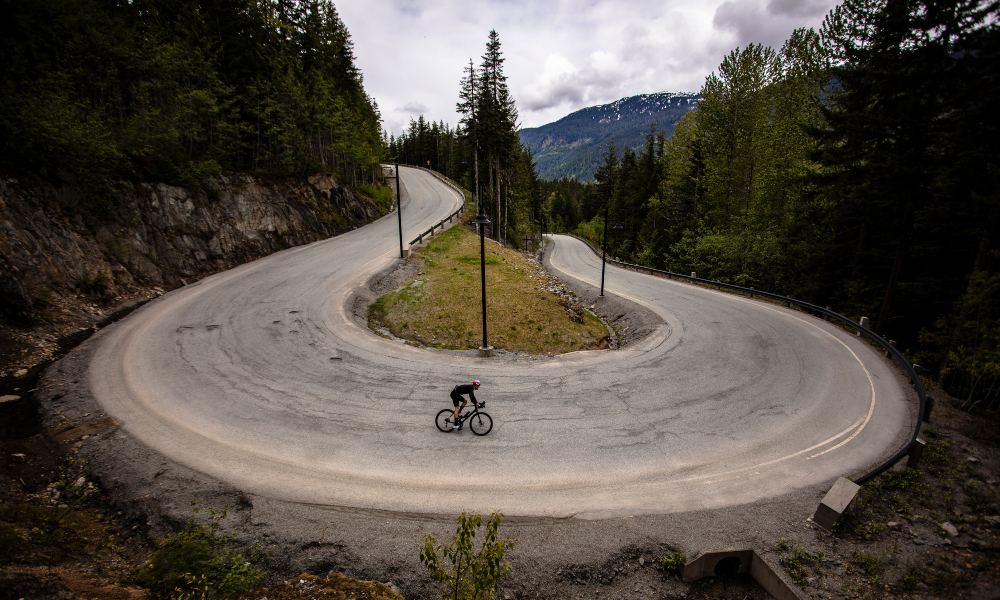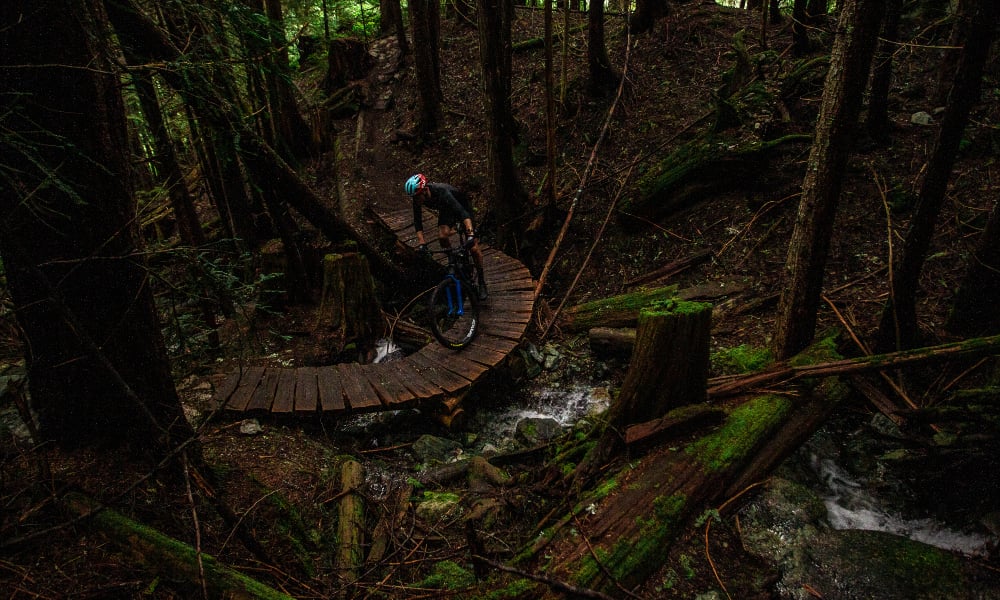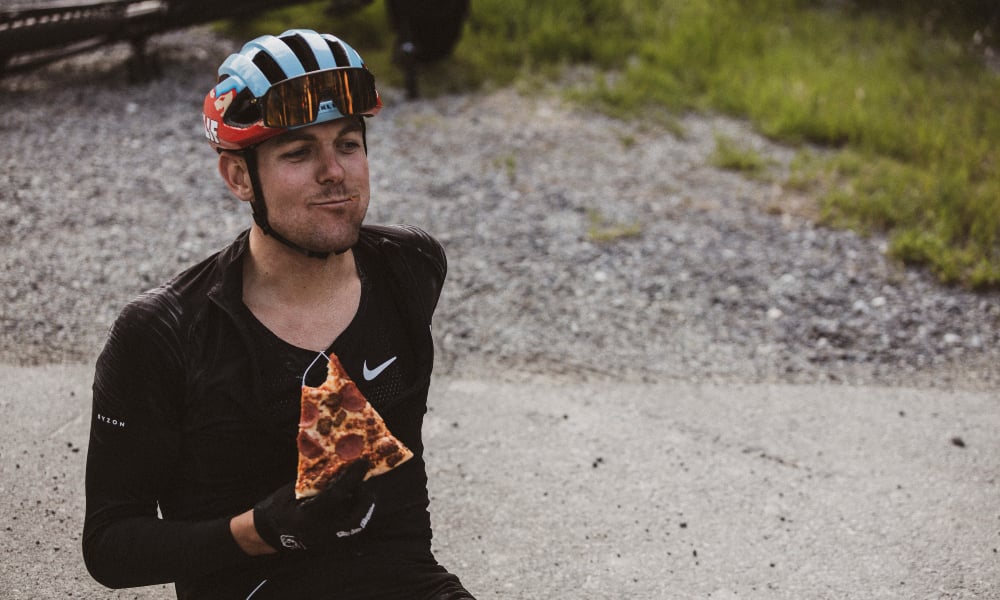Ever since the first reconnaissance mission to explore climbing Mt Everest nearly a century ago, the world’s highest peak has loomed large in the minds of adventurers all over the world. From the first attempt in 1922 through to Suunto Ambassador Kilian Jornet summiting the 8848 m peak twice in one week in 2017, Everest has represented the ultimate challenge.
Like so many things at the moment, Mt Everest is currently closed due to COVID-19. But that doesn’t mean you can’t conquer your own Everest. The closure of travel and racing represents an opportunity to imagine new adventures that inspire the heart and mind. One for the list is ‘Everesting’.

Karsten Madsen cruises on one of the laps in his first Everesting ride back in May. © @matthew.tongue
What is Everesting?
Simple really; pick any hill, anywhere in the world and complete repeats of it until you climb 8848 m – the equivalent height of Mt Everest. The challenge has become particularly popular with cyclists, but can be done on foot or even virtually in the comfort of your own home. Get the job done and you can get your name in the Everesting hall of fame.
How did it start?
The first Everesting event was in 1994. The grandson of the famous mountaineer George Mallory, who disappeared on Mt Everest in 1924, biked up 1069 m Mount Donna Buang in Victoria, Australia eight times. The format and rules were later developed by Australian cyclist Andy van Bergen, who was inspired by Mallory's effort. Andy also heads up the Hell 500 cycling collaborative which runs www.everesting.cc, the global hub for Everesting.
Everesting boom time
We all need goals to aim for. Otherwise our motivation wanes. For athletes and adventurers, COVID-19 wiped out the usual goals, including races and travelling to adventure destinations. Athletes and adventurers have had to find new ways to stay motivated. That’s why FKT (fastest known time) attempts have exploded in number this year. And for the same reason so have Everesting attempts.
Already so far in 2020, the fastest known times for successful Everestings have fallen 10 times in the men’s category, and seven times in the women’s category. At the time of writing this, Irish road racing cyclist Ronan McLaughlin holds the men’s record: 07h04m. Brit and former pro cyclist Emma Pooley holds the women’s record: 08h53m.

Karsten says this Everesting attempt is so tough he might find his breaking point. © @matthew.tongue
Is this the most ambitious Everesting attempt ever?
Professional Xterra triathlete 28-year-old Karsten Madsen has his work cut out for this coming Saturday. Starting at 3am – when the local bears are the most active – the Canadian Suunto athlete will set out on his MTB into the lush forests of British Columbia to attempt to pedal up Mount Sproatt (1826 m) seven times. He’ll start his ascent via the ‘Into the Mystic’ MTB trail which has four pitches so steep he’ll have to maintain 400 watts power to avoid having to push his bike. The descent, via the famous Lord of the Squirrels Trail, won’t afford him any real rest time because of the gnarly terrain, including rock rolls and slabs and a tangle of tree roots. To prepare for the bumpy descents, Karsten has been doing special training for his hands and arms. Each loop is 28.9 km, with 1200 m elevation gain. Karsten aims to finish it in 15 hours.
“This project gets me excited because people who live here in Whistler know that trail well,” he says. “When you tell them you are going to ride it seven times, it blows their minds.
We caught up with Karsten before the ride and asked him about his big adventure.

Carefully monitoring his time and watts on his Suunto 9 will play a key part on the day. © @matthew.tongue
We heard you Everested another peak recently?
Yes, I Everested Whistler Peak (2181 m) in Kadenwood on May 22. I did it on a road bike on local roads. Each of the 39 laps was 6.4 km, with 321 m elevation gain. The total distance was 247 km and my average watts was 300. It took me 11 hours and change. I decided to do it only four days prior to starting.
How is Everesting with a mountain bike on a MTB trail going to be different?
It comes with a logistical nightmare. The loop is a lot longer so I have to be a lot more diligent to make sure I have everything I need on each lap. I need to be self sufficient out there and make sure I get everything I need when I go through basecamp. With this one I'm not totally sure I can pull it off. On the MTB, I don't know. The trail down is really physically hard.
Why did you choose this next trail for an Everesting attempt?
Personal draw. I use it for training a lot. The climb portion of it is very indicative of a lot of the races I do. Plus, growing up in Ontario we didn't have mountains, and the first time I rode up into an alpine environment was up on this trail. It was one of the top five best days in my life. It made me feel amazing in my very soul. I’m also King of the Mountain, or the person with the FKT (fastest known time) on it.

Unlike most Everesting adventures, this one will be tough on the way down, too. © @matthew.tongue
Are these sorts of long adventures your focus now?
Yes and no. COVID opened a different window into another life. These are the sorts of things I planned to do after my racing career ends. I’m in the prime of my endurance life and my goal is to win an Xterra World Championship. Early in the COVID lockdown, we had no idea whether we could race, so we’re just trying to find ways to stay motivated and get in some big blocks of training. If you’re a solutions based person, you'll find a way to make the best out of a terrible situation. I got thinking about how to create an event that is COVID appropriate and that people find interesting. I realised people find long adventures inspiring. Thing is I can do this now because I’m in the prime of my life and have time to recover. It all developed into an opportunity for sponsors to showcase something inspiring happening.
How can people follow your attempt Saturday?
Follow along via my Instagram feed: @karstenmad. I'll be posting updates when I can. And to support, please consider donating here. My lofty goal is to raise $8848, covering every meter of the adventure. Best thing is there is a laundry list of prizes people can win. All the proceeds go to WORCA (Whistler Off-Road Cycling Association) In 2019 they were granted a $120,000 annual budget, and this year, due to COVID, it was slashed to $40,000. I rely so much on these trails. MTBing gives people in this town a break from all this COVID chaos. It's pure therapeutic fun.
You aren’t following the Everesting rule that requires the way up to be the same as the way down?
That’s right. It’s a simple decision really. Part of it is forced. On most MTB trails the trail up is only for climbing. You don't descend it. I understand I'm not following the correct Everesting rule, but literally no one could climb the descent trail. It's so gnarly. Even to go down is full on. You'd be hiking your bike up.

Karsten's family are supporting him, including making sure he gets plenty of calories. © @matthew.tongue
How have you been training for this?
I've done 15 or 16 laps up this year. I know every inch of it. Over a weekend recently some friends and I did a huge gravel ride, including some bushwhacking. We were gone from 6am, to 09.30pm. It was a super hard day. The next day I rode my pacing laps. I have years of endurance training under my belt. I’m also getting plenty of rest. The cool thing about this project is I have learned a lot about training.
What’s your plan for the ride in terms of food and pacing?
Pacing will come from knowing the lap time, and really following power data. If I hold 300 watts I know what that lap time will look like. Having a Suunto 9 will help me keep an eye on the data. I’ve set it up so I can see all the important data fields: time, current power, average power, current heart rate, and elevation gain. I really have to make sure I'm on time with my laps. One risk is riding too hard too early or, alternatively, maybe I let the power slip.
In terms of food, basically every lap I'll be eating a bunch of Cliff bars, blocks, and cookies and drinking a 750ml bottle with 320 calories. Then I’ll introduce flat coke, pretzel sandwiches, and Pringles. I want to have a little real food because I'll need more calories for the way down.
What have you learned from Everesting?
To be a good racer you have to have a robotic feeling. We shut off emotions, like feeling nervous, and get into a kind of tunnel vision just to execute. Then we only start feeling again at the finish line. These Everesting projects are a super soul fulfilling thing. Such a different experience. They can bring a community together, and rally for a cause that’s bigger than yourself. It's not about me, it's about raising money for a cause. Whereas with racing it feels more selfish, just thinking me, me, me, and how can I be better.
Lead images: @matthew.tongue
Read more articles
Welcome to the season of the FKT
Start your path to mountain navigation mastery here
How to adapt your training when the unexpected strikes